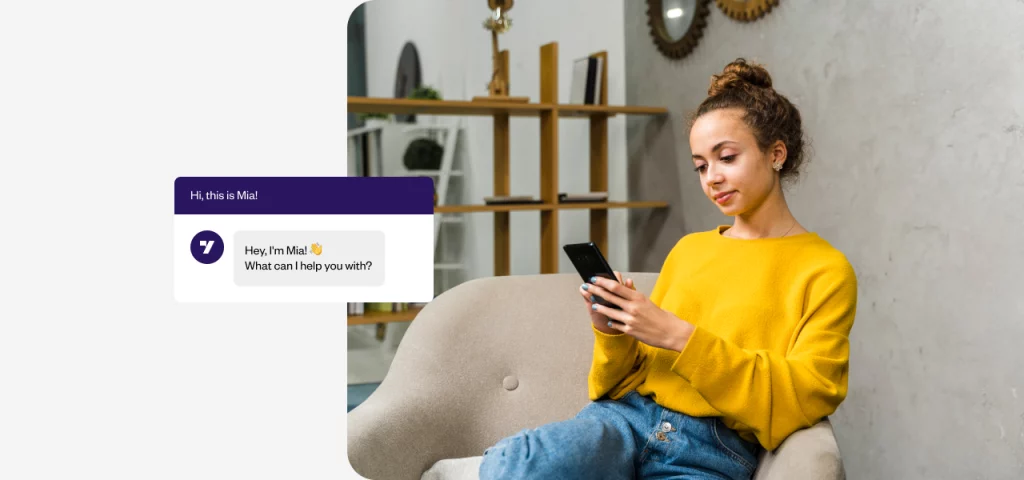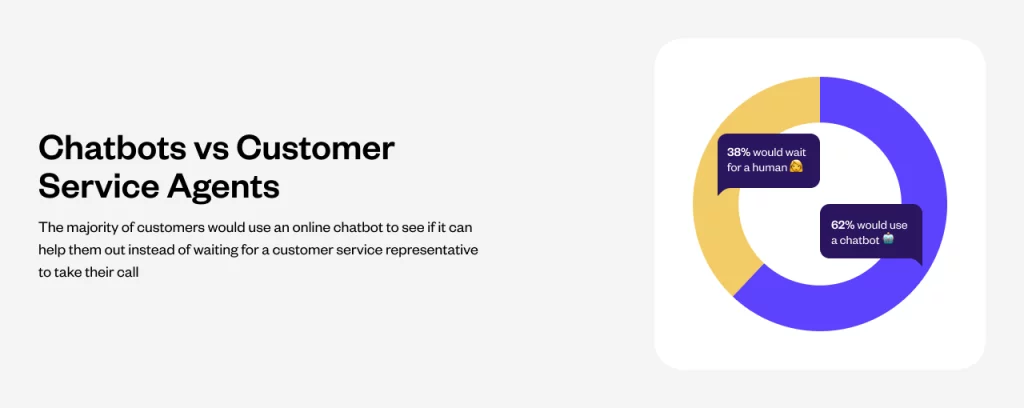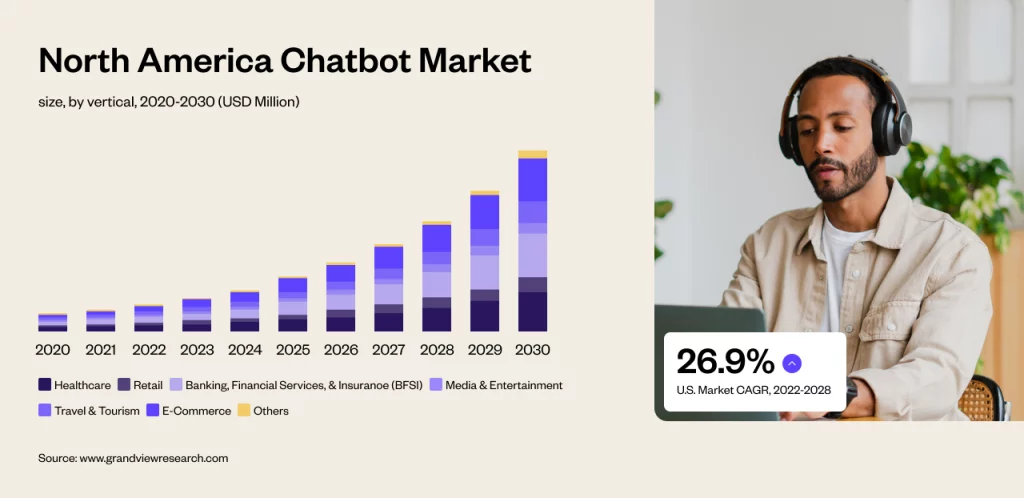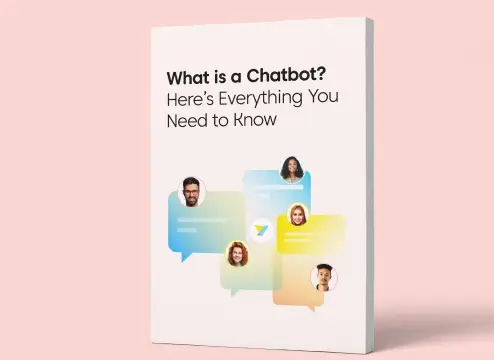Have you noticed how more and more businesses are using chatbots to interact with their customers? These clever little bots are changing the game and making it easier for companies to connect with their audience. And the best part is it’s just the beginning!
“About 88% of customers had at least one conversation with a chatbot within the past year.”
Source: Tidio

As we look ahead to 2023, chatbots are only going to become more popular and transform how businesses handle customer service, sales, and marketing.
This blog covers the following topics:
- Current statistics and chatbot usage and adoption rates
- Chatbot market trends around the world
- Customer expectations
- Future of chatbots
Customers prefer chatbots over human agents

According to research, customers have established a preference for chatbots. They typically turn to chatbots for handling minor issues or when they need quick assistance. As long as the chatbot can respond to their questions in real time and help them quickly resolve their problem, customers don’t mind being served by a chatbot.
Various studies have shown that a significant percentage of consumers prefer chatbots over human agents, especially when it comes to simple questions or getting instant responses.
- 62% of consumers would rather use a customer service bot than wait for a human agent to respond to their requests
- 65% of consumers feel comfortable handling an issue without human intervention
- 74% of internet users prefer chatbots for simple queries.
- 69% prefer chatbots due to their ability to provide instant responses.
Interestingly, some customers do not care whether they are served by a chatbot or a human agent, as long as they receive the necessary support services.
Chatbots are used by businesses of all sizes

Chatbot adoption rates by businesses are steadily increasing as more organizations realize the benefits of using chatbots for customer service, marketing, and sales. Here are some key stats.
- By 2023, it is estimated that the global chatbot market will reach $9.4 billion, with a compound annual growth rate (CAGR) of 29.7% from 2018 to 2023. (MarketsandMarkets)
- A recent survey found that 80% of businesses plan to use chatbots by 2023, with 47% of businesses already using chatbots for customer service. (Oracle)
- In the healthcare industry, chatbot adoption rates are expected to reach 57% by 2023, with virtual assistants used for scheduling appointments and answering patient queries. (Frost & Sullivan)
- The banking and financial services industry is also adopting chatbots rapidly, with adoption rates expected to reach 77% by 2023. They are being used for tasks like account management, balance inquiries, and fraud detection. (Juniper Research)
- The retail industry is also embracing chatbots, with adoption rates expected to reach 73% by 2023. Retailers are using chatbots for tasks like answering customer queries, providing personalized recommendations, and processing orders. (Juniper Research)
- Small and medium-sized businesses (SMBs) are also adopting chatbots, with 50% of SMBs planning to use chatbots by 2023. (Small Business Trends)
Overall, chatbot adoption rates are expected to continue growing as businesses recognize the benefits of using them for improving customer service, increasing efficiency, and driving revenue growth.
Popular chatbot market statistics

More and more people are turning to message apps, and as a result, chatbots are becoming increasingly popular. Customers in the banking, health and wellness sectors have high expectations, and chatbots are proving to be an effective way to meet those demands. By reducing operational costs, chatbots are becoming a top choice for business owners worldwide who are eager to implement them on their websites, Facebook Messenger, WhatsApp, and mobile apps.
- In terms of industry verticals, the banking, financial services, and insurance (BFSI) sector is expected to hold the largest share of the chatbot market in 2023 due to the high adoption rate of chatbots for customer support and transaction processing. (MarketsandMarkets)
- The healthcare industry is also a growing market for chatbots, with virtual assistants used for tasks like appointment scheduling, symptom checking, and medication reminders. The healthcare chatbot market is expected to reach $703.2 million by 2026, growing at a CAGR of 21.2% from 2021 to 2026. (Meticulous Research)
- The retail industry has started to employ chatbots for improving customer service and increasing sales. The retail chatbot market is expected to reach $1.3 billion by 2026, growing at a CAGR of 24.7% from 2021 to 2026. (Meticulous Research)
- The Asia-Pacific region is expected to dominate the chatbot market in terms of growth rate, with a CAGR of 28.8% from 2021 to 2026. (Meticulous Research)
- Among the various types of chatbots, the rule-based chatbot segment is expected to hold the largest market share in 2023, as these chatbots are easy to develop and deploy. (MarketsandMarkets)
Chatbots will dominate social media messaging
As social media continues to evolve, businesses are constantly seeking new ways to engage with their customers and provide excellent customer service. Chatbots provide instantaneous responses to customer inquiries, which is essential in the fast-paced world of social media messaging. This means that businesses can respond to customers quickly, even outside of regular business hours.
- Over 1.3 billion people use Facebook Messenger every month to communicate with friends, family, and businesses. (Facebook)
- More than 20 billion messages are exchanged between people and businesses on Facebook Messenger every month. (Facebook)
- By 2023, it’s estimated that chatbots will save businesses $11 billion per year. (Juniper Research)
- WhatsApp has more than 2 billion monthly active users, making it the most popular messaging app in the world. (WhatsApp)
- 75% of internet users use messaging apps like WhatsApp, Facebook Messenger, or WeChat. (eMarketer)
- In a survey, 80% of businesses reported that they plan to use chatbots for customer interactions by 2023. (Oracle)
- The use of messaging apps for customer service is on the rise, with a 35% increase in usage between 2019 and 2020. (Zendesk)
- 64% of consumers prefer to connect with businesses through messaging apps rather than phone or email. (Facebook)
- According to a survey, 61% of consumers believe that chatbots are the future of customer service. (Ubisend)
- Chatbots can improve customer satisfaction rates by up to 24%, resulting in higher customer retention and loyalty. (Salesforce)
What do customers expect from chatbots?
Customers expect chatbots to provide quick and efficient customer service, personalized assistance, and a human-like conversational experience. They also expect chatbots to recognize when a human touch is needed and escalate the conversation to a live agent who can provide further assistance.
- According to a survey by Drift, 64% of customers expect 24-hour service from chatbots.
- The same survey found that 37% of customers expect chatbots to be able to provide answers to their questions in real time.
- A study by Salesforce found that 69% of customers expect personalized assistance from chatbots based on their purchase history and preferences.
- In the same study, 75% of customers said that they would like to use chatbots to resolve customer service issues, while 73% said they would like to use chatbots to track orders and deliveries.
- According to a report by Grand View Research, the global chatbot market is expected to reach $1.25 billion by 2025, driven by increasing demand for personalized customer experiences and the need for cost-effective customer service solutions.
- A survey by Oracle found that 80% of businesses plan to use chatbots by 2020, while 36% already use them.
- The same survey found that 74% of customers are willing to use chatbots for getting quick answers to simple questions.
These statistics highlight the growing popularity of chatbots among customers, and the increasing demand for personalized, efficient, and round-the-clock customer service.
What makes a good chatbot experience?
A good chatbot should be easy to use, with a clear and intuitive interface that guides the user through the conversation. It should be tailored to the user’s needs and preferences, providing personalized recommendations and solutions.
Not only should a chatbot understand the context of the conversation and provide relevant and helpful responses, but it should also have the capability to seamlessly integrate with other channels, such as email, social media, and phone, to provide a consistent customer experience across all touchpoints.
What is the future trend of chatbots?
To sum it up, chatbots are growing and changing fast, and they’re set to make a big impact in 2023 and beyond. In the upcoming years, we’ll likely see more businesses adopting chatbots in different areas, along with improvements in artificial intelligence and natural language processing, integration with voice assistants, and the development of chatbots that can speak multiple languages.
By embracing these chatbot trends, businesses can stay ahead of the game and enhance their customer engagement and streamline their operations.



















